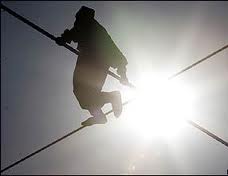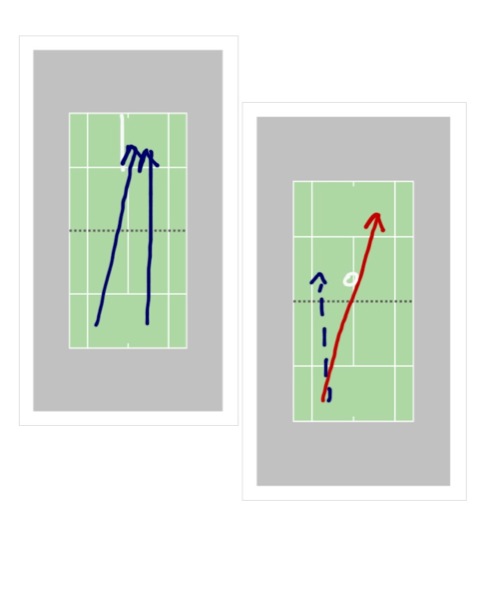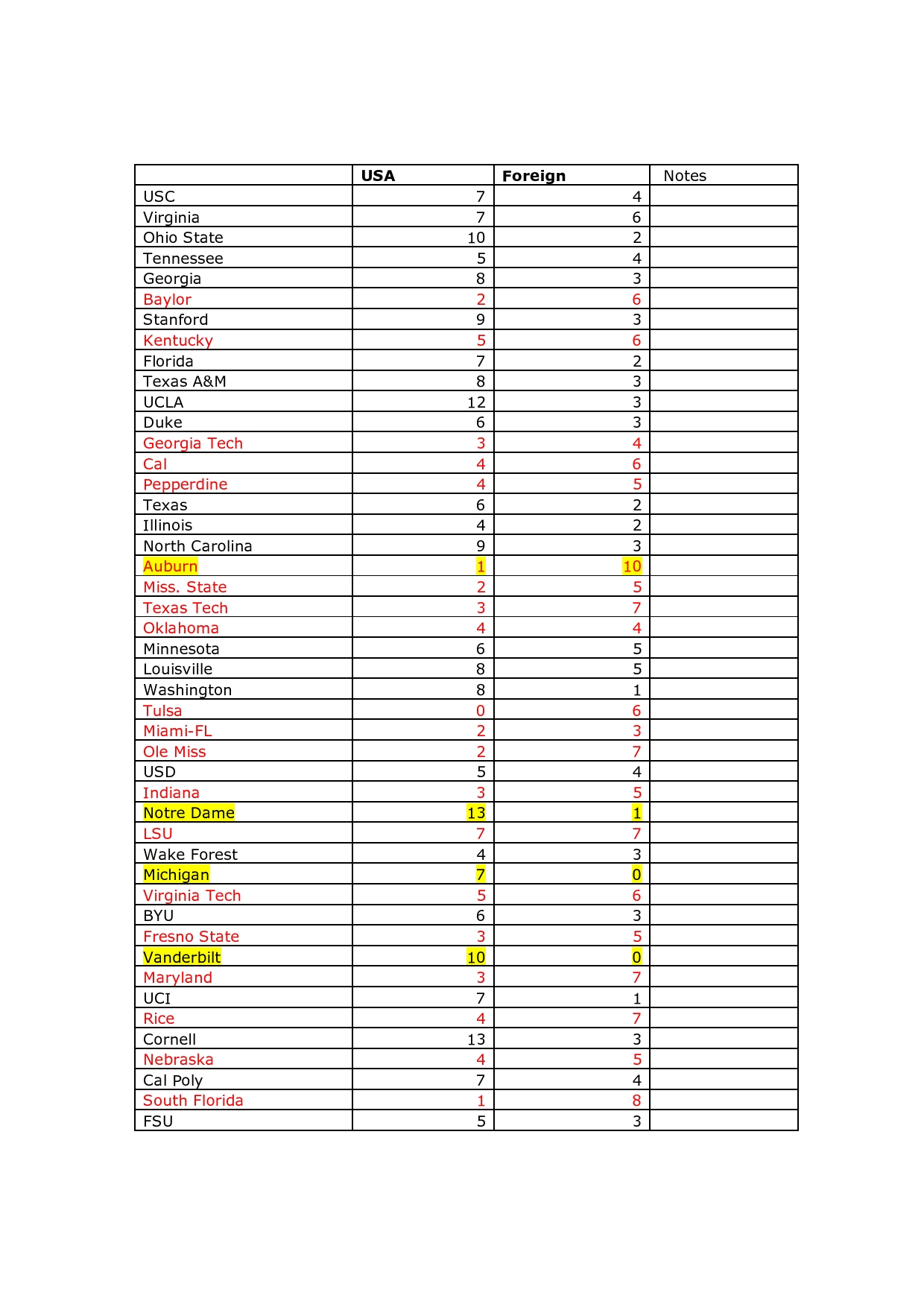 "What if we're going about this the wrong way?" Jack Fawcett must have surely asked his father, Col. Percy Harrison Fawcett, while in the process of getting lost (to their eventual demise) in the Mato Grosso as they were searching for the legendary City of Z in the Brazilian rainforest.
"What if we're going about this the wrong way?" Jack Fawcett must have surely asked his father, Col. Percy Harrison Fawcett, while in the process of getting lost (to their eventual demise) in the Mato Grosso as they were searching for the legendary City of Z in the Brazilian rainforest.
Well, as much talk as has taken place about the state of college tennis and junior development within the United States, we should stop for a moment - before getting lost even further in the forest of Quickstarts bushes, Lil' Mo trees, and Bowl landscapes - and ask ourselves "ARE WE GOING ABOUT THIS THE WRONG WAY?" What if the best way to address the issue is not to treat the temporary symptoms but to purge the causes from our system?! More specific, what if something that's supposed to keep us warm, safe and protected is actually bad for us?! Can you think of some instances where something that's supposed to be good for us causes all kinds of undesirable side-effects? Do you watch much TV? Ever hear the list of side-effect on some of the medicines that are peddled around the clock? Some are worse than the main disease...
With the foregoing in mind, we have engaged in some brief research regarding the effects of "safety nets" on performance. For example, it is often written (and spoken) that college serves as a safety net for athletes. See, for reference, here, here and here. Players train with the thought that college athletics is, somehow, a mid-range objective that is going to propel them into superstardom. Consequently, they don't work very hard in the beginning stages believing that they will do the right things - the grueling work - in college...in other words, candy now, peas and carrots later. Thus, does the existence of the perceived safety net pose a developmental problem for our athletes? Although no on-point discussion exists when it comes to tennis, here are some thoughts from similar fields:
Doug Roxburgh, Director of High Performance for Golf Canada states:
“I think one of the challenges that we have right now is the U.S. college system. Our international counterparts — England and Europe and Australia and New Zealand and the Asian countries — their players don’t go through the U.S. system. They train full-time. They play around the world. They get the experience and they’re much better prepared, in my mind, than our players who are coming out of the U.S. college system. That is a challenge. I think it’s just part of North American culture. You want your kids to get an education. Then, they have something to fall back on"
What?! You mean to tell me, Mr. Ruxburgh, that the US college golf system is not set up to launch players on the professional golf tour? Interesting! To summarize: players who come from places that do not have a collegiate golf system are better prepared. Their players don't rinky-dink around with junior rankings and other such trivialities. They are passionate about the sport and gain exposure to trial-by-fire a lot sooner making them mentally, physically and tactically tougher. Without a safety net, the players are separated into two camps a lot earlier in their development: (1) on the one side are the hit-and-giggle players who play for fun; and (2) on the other, you will find the eat, drink, breathe and dream the sport players (rabidly obsessed players). Can you guess the pool of players from which the top performers are likely to come?
Further studies supporting the theory that safety nets are bad for performance are few and far between. A recent NY Times article entitled “What if the Secret to Success is Failure?” discusses, however, an interesting developmental experiment. The premise of the study was whether students who never, or very seldom, experienced setbacks, could achieve academic success. The study found that:
"the students who persisted in college were not necessarily the ones who had excelled academically at KIPP [charter school organization]; they were the ones with exceptional character strengths, like optimism and persistence and social intelligence. They were the ones who were able to recover from a bad grade and resolve to do better next time; to bounce back from a fight with their parents; to resist the urge to go out to the movies and stay home and study instead; to persuade professors to give them extra help after class. Those skills weren’t enough on their own to earn students a B.A…. But for young people without the benefit of a lot of family resources, without the kind of safety net that their wealthier peers enjoyed, they seemed an indispensable part of making it to graduation day."
OK, so this is only somewhat related to what we are discussing here. However, upon brief consideration, you may find that the distinction is one in terms of timing not scope. For example, in the aforementioned study, the students who performed well had no immediate safety net and, therefore, ended up performing well in the future. In terms of tennis, our players have a future safety net ("oh, if it doesn't work out, I can always go to college and Ill work hard when I get there") and, as a result, they don't prepare well in the present - certainly not to the degree required to perform and dominate on the pro tour (as evidenced by the rankings that really matter). This is particularly obvious if we were to compare college tennis to social security payments and the rate of economic savings per family unit in the United States. Would you save more of your paycheck if you knew that no government check would be forthcomging upon retirment?! Would you work harder if you knew that "not making it" on the tour was a very real boogeyman?
On the other hand, let's see who dominates the sport of tennis: Spaniards, South Americans and Central/Eastern Europeans. Look at their collegiate athletic system:..................[crickets chirping]. Much like golfers in Mr. Roxburgh's example, they train from early age without a safety net. For them, there is no "spring-board" to the pros fallacy and they are not handcuffed by principles of amateurism. The ones who really care about the sport live the sport. Others, play for pleasure - which is fine too. But everyone is honest with their intentions and passion for the game.
Parhaps, rather than trying to fix the college tennis system (which is not designed to produce ATP/WTA top-10, top-50 or even top-100 players), we should think about disbanding/jettisoning it altogether. Sounds radical? It absolutely is! But given the state of US tennis, it is foreseeable that a radical approach is necessary in order to turn this ship around. Of course, it will not happen as there are way too many vested interests in keeping the system as it is (e.g., membership fees, tournament fees, lessons, marketing useless training systems or immoral services). But think about what would happen if, starting tomorrow, there would be no college tennis:
1. A lot of players would quit. Why? They are playing for a "wrong" reason. They don't really love tennis, they only like what tennis could do for them (a small carrot, that looks quite large, at the end of a very long stick). Did we mention that it costs $450,000 to develop a tennis player and scholarship is only worth about $100,000 (if you're good enough to actually get a full one)? Aren't you better off by saving some money and actually paying for school?! Even if a lot of players quit, the ones who stay on will be like musicians or artists who are obsessed about their craft. They will challenge each other at every step of their development and, due to their passion for the game, better players would emerge (every match would be a fight between tigers).
Hey, there's a thought: do musicians obtain collegiate scholarships based on their results or rankings? No! They play - improve and develop - because they possess a true passion for their art regardless of potential payoffs down the road. Also, the lack of scholarships doesn't prevent them from going to college. The same mentality would certainly help our best junior players.
2. A lot of coaches would be put out of business. Good! The bad ones will certainly be out of a job; the good ones, just like good coaches in Europe and other parts of the world, will continue to be swamped with lessons as people will always try to improve their game. In a similar vein, a lot of organizations may fold or be forced to downsize. Is this so bad? What are they doing for the game of tennis right now?! Aren't they just supported by the artificial demand that they themselves have helped create by peddling misinformation like hot cakes?! At the very least, there would be a system where the grittiest kids would be developed by the best coaches. From a developmental point of view, that's not exactly a bad thing.
3. There will be fewer tournaments. After all, with fewer players the demand for more competition will decrease. Maybe! France has thousands of tournaments for player at every level. In the summer, it's possible to sign up for and play an event a day. Tournaments are driven by passion; not a profit motive. There will always be supply if the demand is there. Right now, the demand is propped up by artificial means (e.g. requiring players to chase ranking points). Accordingly, the current demand for tennis itself is itself distorted. Perhaps a new system of club tennis or private leagues would emerge.
4. Rankings will be meaningless. Awesome! You don't need a junior ranking to get on "the tour"; all you need to do is sign up. Imagine a system where players played tournaments because of the competitive benefits and not to chase points! You wouldn't have to struggle to finance a cross-country trip to a national open or a long-distance drive to some silly designated event. You could play the tournament you want, when you want for the developmental benefits. Isn't this what most good coaches are saying now anyway (i.e., focus on learning not on chasing points)?
5. Education level will increase. This is a bad thing? Isn't the purpose of college to get an education? Somewhere along the lines, someone, somewhere put it in players'/parents' minds that college is a step towards the pro tour. If only....someone...could rem--- got it..here. Presently, there are a ton of would-be student-athletes who sacrifice education in pursuit of a lofty dream. Many don't get the most out of school because they have to play this tournament for ranking, travel to that one because that's where the coaches are going to scope out potential recruits, or choose between a book-report and a practice. Same thing happens in college where you have to practice with the team and are generally relegated to classes that fit around the tennis schedule. Without college tennis as an objective, you could focus on your studies (before and during college) and make tennis fit your schedule (not the other way around).
6. Your tennis may actually improve. You could work on your game at your convenience and without the need to keep up with the Joneses. You could actually focus on development and learning as opposed to chasing points. Your parents might actually be saving money in this process. You wouldn't need to worry about amateurism rules. Therefore, you would actually have a tangible incentive to play. In college, you could set up the practices, workouts and tournaments around your needs and schedule. You could take a semester/quarter off and play French tennis tournaments, Bundesliga or Italian team events. You could play futures in South America or money events in Asia. In other words, you could do both tennis and school at your convenience. On this note, did you know that Tipsarevic, Ancic and Zvonareva have college degrees? Tennis didn't seem to interfere with their studies.
7. Players will not be able to pursue higher education. Who says?! First of all, if parents have the funds to spend on developing a player (again, avg. $450,000/player) they should certainly be in a position to have some money set aside for college. If they are "investing" $450,000 to obtain something of substantially lesser value, they need to be put under conservatorship. Of course, these actions certainly explains the state of economic affairs in the United States. Second, with better grades, a player will be more likely to get in a school of his/her choice. Lastly, what's wrong with working and paying for school the old-fashioned way?! A lot of student are doing it and just because you own a couple of rackets and some tennis posters doesn't make you special.
Rather than fixing a broken system, perhaps the best approach is to discard the system altogether. Like Hernan Cortes who burned his ships (all of them, per legend) to prevent his troops from turning back to the protection of the empire and ended up conquering the Aztec empire, maybe it's time for us to also "go all in"...to wean away from the nipple.
If this approach doesn't work (and given the nature of disappearing programs, it's just a matter of time before it will happen on its own), here's another less-radical thought: approach the game as if the collegiate athletic system doesn't exist. After all, the top professional tennis players regard tennis with the same frame of mind: there is no college; only pros. Then, again, they have true passion for the game. Do you? Are you sure?! Ask yourself: if they disbanded college tennis tomorrow, would I still practice 4 hours a day? Would I still grind it in the gym or on the track? Would I still play this tournament or that? Would I still try to be the best that I could be? If the answer's yes, then at least your attitude is on the right track. For those of you who have stuck with me this far, this is really the point of this article... finding something that you're passionate about (hopefully, tennis) and then pursuing it with all your heart and resources as well as not being distracted by vista points along completely different routes.
 Friday, December 16, 2011 at 12:21PM
Friday, December 16, 2011 at 12:21PM  CAtennis
CAtennis  Have you ever made it to a third set against a tough opponent, come close to winning but, due to fatigue, managed to only snatch defeat from the jaws of victory?! If so, you understand the role of proper physical conditioning when it comes to tennis. Unfortunately, too many players don't play enough sets (particularly THREE SETS IN A ROW) or train hard enough to get themselves in the best possiible position to win. Often times, this a result of lack of time or inexperience. However, assuming that you are motivated to learn and improve, here is one way to train for the third set if you only have one hour available:
Have you ever made it to a third set against a tough opponent, come close to winning but, due to fatigue, managed to only snatch defeat from the jaws of victory?! If so, you understand the role of proper physical conditioning when it comes to tennis. Unfortunately, too many players don't play enough sets (particularly THREE SETS IN A ROW) or train hard enough to get themselves in the best possiible position to win. Often times, this a result of lack of time or inexperience. However, assuming that you are motivated to learn and improve, here is one way to train for the third set if you only have one hour available:






